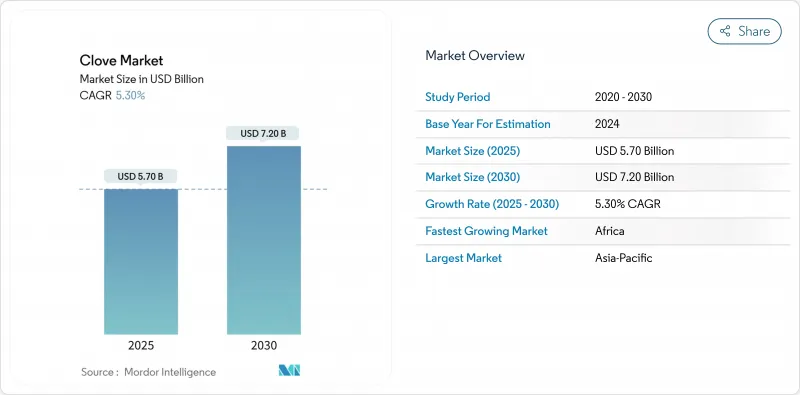
|
市場調査レポート
商品コード
1850955
クローブ:市場シェア分析、産業動向、統計、成長予測(2025年~2030年)Clove - Market Share Analysis, Industry Trends & Statistics, Growth Forecasts (2025 - 2030) |
||||||
カスタマイズ可能
適宜更新あり
|
|||||||
| クローブ:市場シェア分析、産業動向、統計、成長予測(2025年~2030年) |
|
出版日: 2025年06月04日
発行: Mordor Intelligence
ページ情報: 英文 120 Pages
納期: 2~3営業日
|
概要
クローブ市場規模は2025年に57億米ドルと推定・予測され、市場推計・予測期間中のCAGRは5.3%で、2030年には72億米ドルに達すると予測されます。

需要は依然としてインドネシアのクレテック・タバコ部門に集中しているが、食品保存、パーソナルケア、創薬への幅広い採用が収益源を拡大し、周期的リスクを軽減しています。北米と欧州では天然防腐剤への嗜好が高まっており、合成添加物への規制が厳しくなっていることも相まって、アクティブ・パッケージングとコンビニエンス・フードにおけるクローブエッセンシャルオイルの利用が加速しています。マダガスカルとタンザニアでは、農業再生への並行投資によって生産物の品質が向上し、アフリカがプレミアム輸出のニッチ分野での課題者として位置づけられています。一方、ブロックチェーンに対応したトレーサビリティは、欧州連合(EU)および日本で高値で取引される認証セグメントを開拓しつつあります。
世界のクローブ市場の動向と洞察
天然保存料およびエッセンシャルオイル源としての利用拡大
食品メーカーは合成保存料を削減し、抗菌成分が豊富なエッセンシャルオイルを採用しています。オイゲノール90%から成るクローブオイルは、Shigella flexneriとSalmonella entericaに対する有効性が実証されており、肉、乳製品、焼き菓子の保存期間を延長します。アクティブパッケージング・イノベーターは、クローブの活性剤をポリマーフィルムに埋め込み、製品の風味を変えることなく安全性を高めています。クリーンラベル製品開発者による需要の高まりは、食品用クローブオイルの消費を押し上げ、商品スパイス取引以外の収益プールを広げています。
便利な食品用スパイス・ブレンドの成長
欧州、北米、アジアの都市部の家庭では、レストランの味を再現した、すぐに使える調味料ミックスの購入が増えています。こうしたブレンドはクローブ、シナモン、その他の体を温めるスパイスを組み合わせたものが多く、料理の伝統を手軽なパントリーの主食に変換しています。リモートワークの文化は家庭での調理の機会を長くし、生産者はブレンドフォーマットを生のクローブ同等品より35%高い価格で販売し、単位当たりのリターンを向上させています。そのため、製品開発チームは、風味の精度を維持するために、安定した揮発性油脂プロファイルを持つクローブの安定供給を求めています。
天候による価格変動
マダガスカルではサイクロンにより2024年の生産量が減少しました。タンザニアでも同様の干ばつが発生し、地域の供給が逼迫したため、スポット・バイヤーは高値での再交渉を余儀なくされました。価格の予測不可能性は食品加工業者にとって長期契約の妨げとなり、合成オイゲノールや代替スパイスによる代替リスクを高める。
セグメント分析
クローブ市場レポートは地域別(北米、欧州、アジア太平洋、その他)に分類されています。生産分析(数量)、消費分析(金額と数量)、輸出分析(金額と数量)、輸入分析(金額と数量)、価格動向分析を含みます。市場予測は金額(米ドル)と数量(メトリックトン)で提供されます。
地域分析
アジア太平洋地域が世界のクローブ市場を独占しており、インドネシアが世界生産の70%以上を占めています。スリランカが5,722トン、中国が1,320トンでこれに続きます。インドネシアが市場をリードしているのは、主要な生産国であると同時に消費国でもあることに起因しており、国内のクレテック・タバコ産業は国内生産量の85~90%を消費しています。この地域は、クローブエッセンシャルオイルの抽出にも進出しており、インドネシアは原料の価値を高めるために新たな加工施設を開発しています。2023年には、インドネシアは主にサウジアラビア、インド、バングラデシュ、アラブ首長国連邦、米国、パキスタンに輸出しており、サウジアラビアとインドが主な輸入国となっています。
アフリカは最も急成長している地域市場であり、2025~2030年のCAGRは9%と予測され、生産能力と加工インフラへの投資に支えられています。マダガスカル、タンザニア、コモロはかなりの生産量を維持しています。この地域は、老朽化したプランテーションの改修と収量の品質向上を目的とした植え替えプログラムと政府補助金の恩恵を受けています。タンザニアのモロゴロ地方は2022年に約2,000トンのクローブを生産し、タンザニア南部農業回廊(SAGCOT)構想を通じて国の生産量に大きく貢献しています。
欧州はクローブの実質的な輸入市場を維持しており、オランダが主要貿易ハブとして機能し、ドイツ、英国、フランス、スペイン、ポーランドがこれに続きます。アジア料理の人気の高まりと、コンビニエンス・フードにおける特殊なスパイス・ブレンドの使用の増加により、地域の需要が増加しています。新興諸国からの欧州からの輸入は2018年から2022年にかけて毎年2.5%増加し、2021年には3,500トンに達し、マダガスカルはオランダとドイツへの主要供給国となっています。
その他の特典:
- エクセル形式の市場予測(ME)シート
- 3ヶ月間のアナリストサポート
よくあるご質問
目次
第1章 イントロダクション
- 調査の前提条件と市場の定義
- 調査範囲
第2章 調査手法
第3章 エグゼクティブサマリー
第4章 市場情勢
- 市場概要
- 市場促進要因
- インドネシアのクレテックタバコ産業からの需要増加
- 天然防腐剤やエッセンシャルオイルの原料としての利用拡大
- インスタント食品用スパイスブレンドの成長
- 認証クローブのブロックチェーントレーサビリティプレミアム
- マダガスカルとタンザニアにおける植林補助金
- オイゲノール系有効成分に対する製薬業界の関心
- 市場抑制要因
- 天候による価格変動
- 不純物混入と品質のばらつき
- EUの農薬/アフラトキシン規制強化
- 合成オイゲノール代替物
- バリュー/サプライチェーン分析
- 規制情勢
- テクノロジーの展望
- PESTEL分析
第5章 市場規模と成長予測(価値と量)
- 地域別(生産分析(数量)、消費分析(数量・金額)、輸入分析(数量・金額)、輸出分析(数量・金額)、価格動向分析)
- 北米
- 米国
- カナダ
- 欧州
- ドイツ
- フランス
- 英国
- イタリア
- オランダ
- スペイン
- アジア太平洋地域
- インドネシア
- インド
- 中国
- スリランカ
- ベトナム
- マレーシア
- シンガポール
- 南米
- ブラジル
- アルゼンチン
- チリ
- 中東
- サウジアラビア
- アラブ首長国連邦
- アフリカ
- コモロ
- ケニア
- タンザニア
- マダガスカル
- 北米


